2019 KIA STINGER trailer
[x] Cancel search: trailerPage 398 of 555

5145
Driving your vehicle
We do not recommend using this
vehicle for trailer towing.
TRAILER TOWING
Page 399 of 555
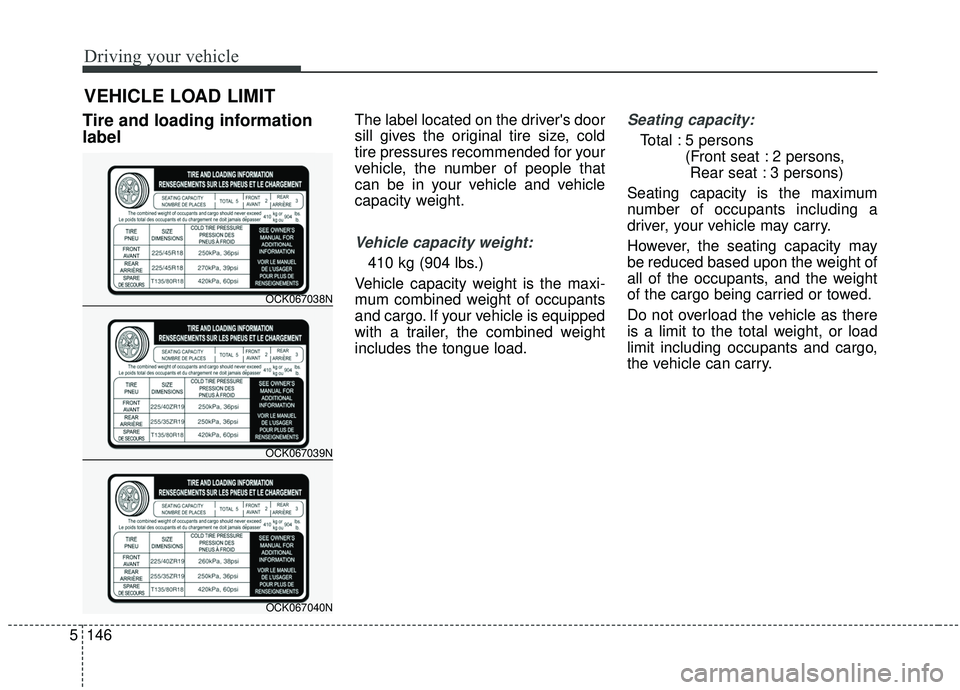
Driving your vehicle
146
5
Tire and loading information
labelThe label located on the driver's door
sill gives the original tire size, cold
tire pressures recommended for your
vehicle, the number of people that
can be in your vehicle and vehicle
capacity weight.
Vehicle capacity weight:
410 kg (904 lbs.)
Vehicle capacity weight is the maxi-
mum combined weight of occupants
and cargo. If your vehicle is equipped
with a trailer, the combined weight
includes the tongue load.
Seating capacity:
Total : 5 persons (Front seat : 2 persons, Rear seat : 3 persons)
Seating capacity is the maximum
number of occupants including a
driver, your vehicle may carry.
However, the seating capacity may
be reduced based upon the weight of
all of the occupants, and the weight
of the cargo being carried or towed.
Do not overload the vehicle as there
is a limit to the total weight, or load
limit including occupants and cargo,
the vehicle can carry.
VEHICLE LOAD LIMIT
OCK067038N
OCK067039N
OCK067040N
Page 400 of 555
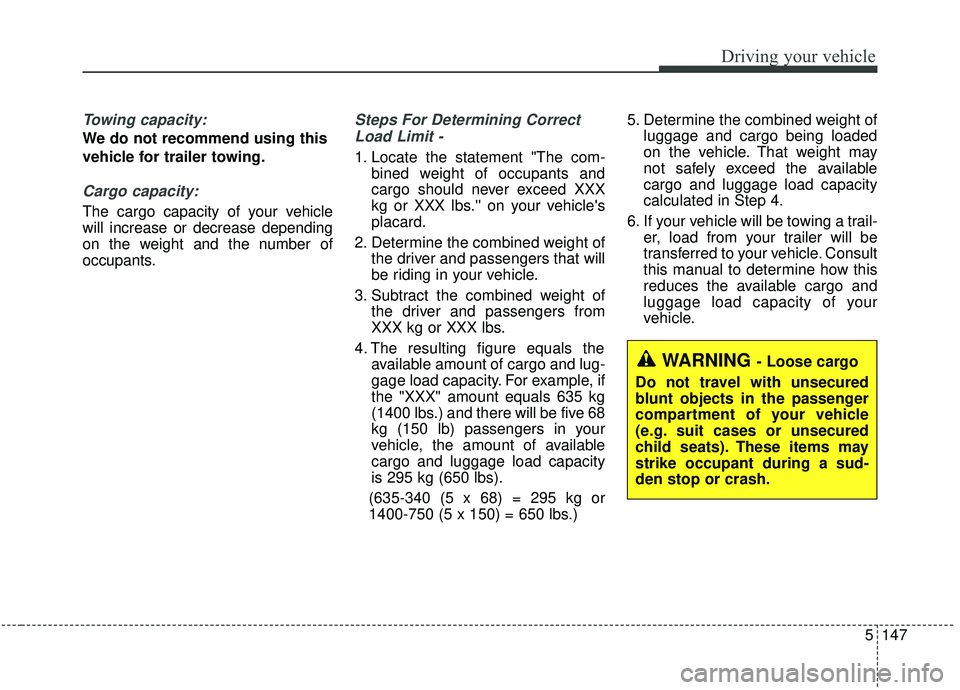
5147
Driving your vehicle
Towing capacity:
We do not recommend using this
vehicle for trailer towing.
Cargo capacity:
The cargo capacity of your vehicle
will increase or decrease depending
on the weight and the number of
occupants.
Steps For Determining CorrectLoad Limit -
1. Locate the statement "The com- bined weight of occupants and
cargo should never exceed XXX
kg or XXX lbs.'' on your vehicle's
placard.
2. Determine the combined weight of the driver and passengers that will
be riding in your vehicle.
3. Subtract the combined weight of the driver and passengers from
XXX kg or XXX lbs.
4. The resulting figure equals the available amount of cargo and lug-
gage load capacity. For example, if
the "XXX" amount equals 635 kg
(1400 lbs.) and there will be five 68
kg (150 lb) passengers in your
vehicle, the amount of available
cargo and luggage load capacity
is 295 kg (650 lbs).
(635-340 (5 x 68) = 295 kg or
1400-750 (5 x 150) = 650 lbs.) 5. Determine the combined weight of
luggage and cargo being loaded
on the vehicle. That weight may
not safely exceed the available
cargo and luggage load capacity
calculated in Step 4.
6. If your vehicle will be towing a trail- er, load from your trailer will be
transferred to your vehicle. Consult
this manual to determine how this
reduces the available cargo and
luggage load capacity of your
vehicle.
WARNING - Loose cargo
Do not travel with unsecured
blunt objects in the passenger
compartment of your vehicle
(e.g. suit cases or unsecured
child seats). These items may
strike occupant during a sud-
den stop or crash.
Page 403 of 555

This chapter will guide you in the
proper loading of your vehicle and/or
trailer, to keep your loaded vehicle
weight within its design rating capa-
bility, with or without a trailer.
Properly loading your vehicle will
provide maximum return of the vehi-
cle design performance. Before load-
ing your vehicle, familiarize yourself
with the following terms for determin-
ing your vehicle's weight ratings, with
or without a trailer, from the vehicle's
specifications and the compliance
label:Base curb weight
This is the weight of the vehicle
including a full tank of fuel and all
standard equipment. It does not
include passengers, cargo, or option-
al equipment.
Vehicle curb weight
This is the weight of your new vehicle
when you picked it up from your deal-
er plus any aftermarket equipment.
Cargo weight
This figure includes all weight added
to the Base Curb Weight, including
cargo and optional equipment.
GAW (Gross axle weight)
This is the total weight placed on
each axle (front and rear) - including
vehicle curb weight and all payload.GAWR (Gross axle weight rating)
This is the maximum allowable
weight that can be carried by a single
axle (front or rear). These numbers
are shown on the compliance label.
The total load on each axle must
never exceed its GAWR.
GVW (Gross vehicle weight)
This is the Base Curb Weight plus
actual Cargo Weight plus passen-
gers.
GVWR (Gross vehicle weight rating)
This is the maximum allowable
weight of the fully loaded vehicle
(including all options, equipment,
passengers and cargo). The GVWR
is shown on the certification label
located on the driver’s door sill.
VEHICLE WEIGHT
5 150
Driving your vehicle
Page 424 of 555
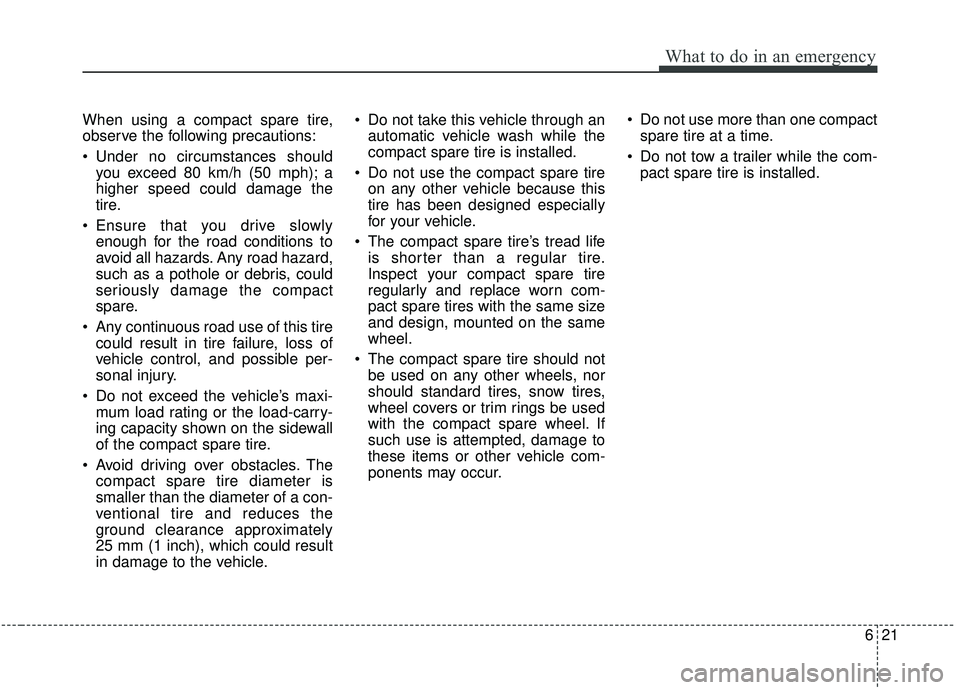
621
What to do in an emergency
When using a compact spare tire,
observe the following precautions:
Under no circumstances shouldyou exceed 80 km/h (50 mph); a
higher speed could damage the
tire.
Ensure that you drive slowly enough for the road conditions to
avoid all hazards. Any road hazard,
such as a pothole or debris, could
seriously damage the compact
spare.
Any continuous road use of this tire could result in tire failure, loss of
vehicle control, and possible per-
sonal injury.
Do not exceed the vehicle’s maxi- mum load rating or the load-carry-
ing capacity shown on the sidewall
of the compact spare tire.
Avoid driving over obstacles. The compact spare tire diameter is
smaller than the diameter of a con-
ventional tire and reduces the
ground clearance approximately
25 mm (1 inch), which could result
in damage to the vehicle. Do not take this vehicle through an
automatic vehicle wash while the
compact spare tire is installed.
Do not use the compact spare tire on any other vehicle because this
tire has been designed especially
for your vehicle.
The compact spare tire’s tread life is shorter than a regular tire.
Inspect your compact spare tire
regularly and replace worn com-
pact spare tires with the same size
and design, mounted on the same
wheel.
The compact spare tire should not be used on any other wheels, nor
should standard tires, snow tires,
wheel covers or trim rings be used
with the compact spare wheel. If
such use is attempted, damage to
these items or other vehicle com-
ponents may occur. Do not use more than one compact
spare tire at a time.
Do not tow a trailer while the com- pact spare tire is installed.
Page 440 of 555
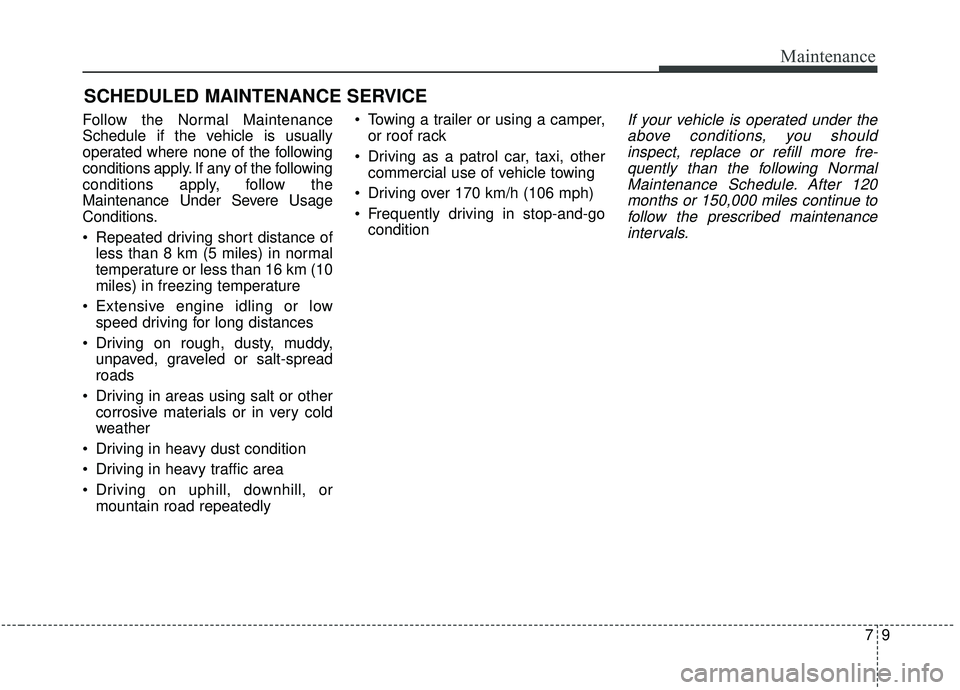
79
Maintenance
SCHEDULED MAINTENANCE SERVICE
Follow the Normal Maintenance
Schedule if the vehicle is usually
operated where none of the following
conditions apply. If any of the following
conditions apply, follow the
Maintenance Under Severe Usage
Conditions.
Repeated driving short distance ofless than 8 km (5 miles) in normal
temperature or less than 16 km (10
miles) in freezing temperature
Extensive engine idling or low speed driving for long distances
Driving on rough, dusty, muddy, unpaved, graveled or salt-spread
roads
Driving in areas using salt or other corrosive materials or in very cold
weather
Driving in heavy dust condition
Driving in heavy traffic area
Driving on uphill, downhill, or mountain road repeatedly Towing a trailer or using a camper,
or roof rack
Driving as a patrol car, taxi, other commercial use of vehicle towing
Driving over 170 km/h (106 mph)
Frequently driving in stop-and-go conditionIf your vehicle is operated under theabove conditions, you shouldinspect, replace or refill more fre-quently than the following NormalMaintenance Schedule. After 120months or 150,000 miles continue tofollow the prescribed maintenanceintervals.
Page 446 of 555
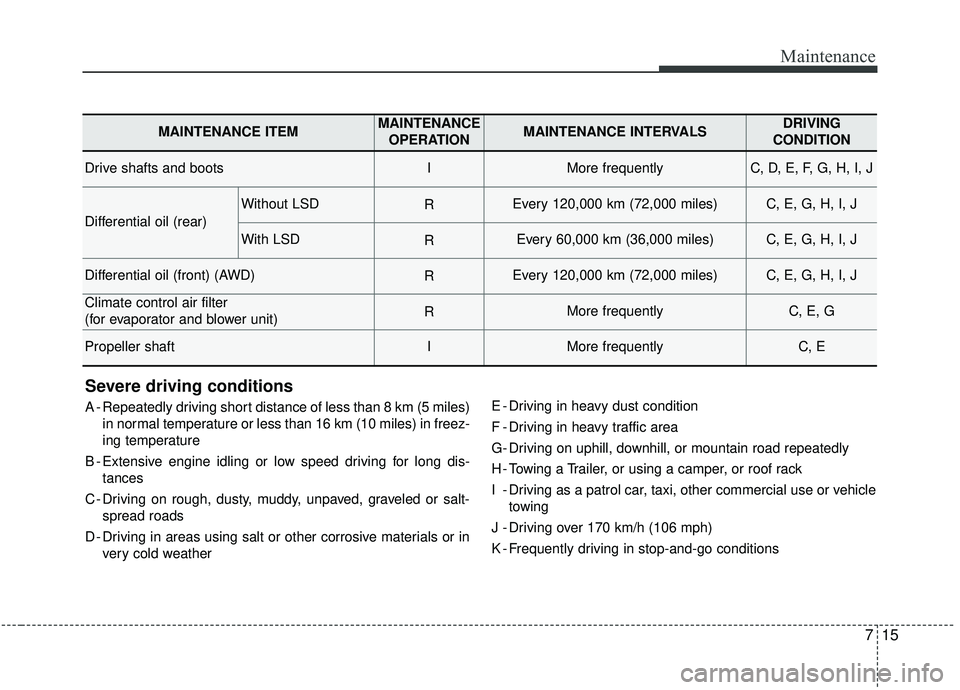
715
Maintenance
Severe driving conditions
A - Repeatedly driving short distance of less than 8 km (5 miles)in normal temperature or less than 16 km (10 miles) in freez-
ing temperature
B - Extensive engine idling or low speed driving for long dis- tances
C - Driving on rough, dusty, muddy, unpaved, graveled or salt- spread roads
D - Driving in areas using salt or other corrosive materials or in very cold weather E - Driving in heavy dust condition
F - Driving in heavy traffic area
G- Driving on uphill, downhill, or mountain road repeatedly
H - Towing a Trailer, or using a camper, or roof rack
I - Driving as a patrol car, taxi, other commercial use or vehicle
towing
J - Driving over 170 km/h (106 mph)
K - Frequently driving in stop-and-go conditions
MAINTENANCE ITEMMAINTENANCE OPERATIONMAINTENANCE INTERVALSDRIVING
CONDITION
Drive shafts and bootsIMore frequentlyC, D, E, F, G, H, I, J
Differential oil (rear)
Without LSDREvery 120,000 km (72,000 miles)C, E, G, H, I, J
With LSDREvery 60,000 km (36,000 miles)C, E, G, H, I, J
Differential oil (front) (AWD)REvery 120,000 km (72,000 miles)C, E, G, H, I, J
Climate control air filter
(for evaporator and blower unit)RMore frequentlyC, E, G
Propeller shaftIMore frequentlyC, E
Page 555 of 555

Index
10I
Warning and indicator lights. . . . . . . . . . . . . . . . . . . . . 4-92Indicator lights . . . . . . . . . . . . . . . . . . . . . . . . . . . . 4-100
Warning lights . . . . . . . . . . . . . . . . . . . . . . . . . . . . . 4-92
Washer fluid . . . . . . . . . . . . . . . . . . . . . . . . . . . . . . . . . 7-27 Checking the washer fluid level . . . . . . . . . . . . . . . . 7-27
Welcome system . . . . . . . . . . . . . . . . . . . . . . . . . . . . . 4-130 Headlight (Headlamp) escort function . . . . . . . . . . 4-130
Interior light . . . . . . . . . . . . . . . . . . . . . . . . . . . . . . 4-130
Pocket lamp . . . . . . . . . . . . . . . . . . . . . . . . . . . . . . 4-130
Wide sunroof. . . . . . . . . . . . . . . . . . . . . . . . . . . . . . . . . 4-45 Closing the sunroof . . . . . . . . . . . . . . . . . . . . . . . . . 4-49
Resetting the sunroof . . . . . . . . . . . . . . . . . . . . . . . . 4-50
Sliding the sunroof . . . . . . . . . . . . . . . . . . . . . . . . . . 4-47
Sunroof open warning . . . . . . . . . . . . . . . . . . . . . . . 4-46
Sunshade. . . . . . . . . . . . . . . . . . . . . . . . . . . . . . . . . . 4-47\
Tilting the sunroof . . . . . . . . . . . . . . . . . . . . . . . . . . 4-49
Windows . . . . . . . . . . . . . . . . . . . . . . . . . . . . . . . . . . . . \
4-34 Power windows . . . . . . . . . . . . . . . . . . . . . . . . . . . . 4-35
Windshield defrosting and defogging. . . . . . . . . . . . . 4-146 Automatic climate control system . . . . . . . . . . . . . 4-146
Automatic ventilation . . . . . . . . . . . . . . . . . . . . . . . 4-149
Defogging logic . . . . . . . . . . . . . . . . . . . . . . . . . . . 4-147
Smart ventilation . . . . . . . . . . . . . . . . . . . . . . . . . . 4-149
Winter driving . . . . . . . . . . . . . . . . . . . . . . . . . . . . . . . 5-142 Carry emergency equipment . . . . . . . . . . . . . . . . . 5-144
Change to “winter weight” oil if necessary . . . . . . 5-143 Check battery and cables . . . . . . . . . . . . . . . . . . . . 5-143
Check spark plugs and ignition system . . . . . . . . . 5-143
Don’t let your parking brake freeze . . . . . . . . . . . . 5-144
Don't let ice and snow accumulate underneath . . . 5-144
Snowy or icy conditions . . . . . . . . . . . . . . . . . . . . . 5-142
To keep locks from freezing. . . . . . . . . . . . . . . . . . 5-144
Trailer towing . . . . . . . . . . . . . . . . . . . . . . . . . . . . . 5-145
Use approved window washer anti-freeze in
system. . . . . . . . . . . . . . . . . . . . . . . . . . . . . . . . . . 5-14\
4
Use high quality ethylene glycol coolant. . . . . . . . 5-143
Wiper blades . . . . . . . . . . . . . . . . . . . . . . . . . . . . . . . . . 7-32 Blade inspection . . . . . . . . . . . . . . . . . . . . . . . . . . . . 7-32
Blade replacement . . . . . . . . . . . . . . . . . . . . . . . . . . 7-32
Wipers and washers . . . . . . . . . . . . . . . . . . . . . . . . . . 4-122 Front windshield washers. . . . . . . . . . . . . . . . . . . . 4-124
Windshield wipers . . . . . . . . . . . . . . . . . . . . . . . . . 4-122
360° camera monitoring system . . . . . . . . . . . . . . . . . 4-112
W
ETC